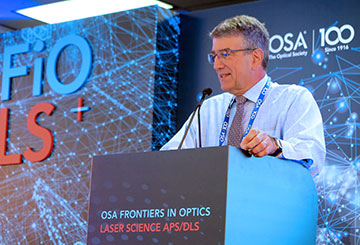
Jon Zuegel at FiO. [Image: Alessia Kirkland]
In March, leading experts from the United States ultrafast laser community met at OSA Headquarters in Washington, D.C., to participate in the Brightest Light Initiative workshop, where they identified future opportunities for the science and technology of high-brightness lasers.
In a Tuesday morning session at Frontiers in Optics+Laser Science 2019, BLI Technology Co-Chair Jon Zuegel of the Laboratory for Laser Energetics (LLE), Rochester, N.Y., shared the outcomes of the workshop with the wider optics community.
A hard truth
In December 2017, the National Academy of Sciences (NAS) released a report stating that the United States had fallen behind in ultrafast laser technology, and that Europe and Asia had surpassed the U.S. to dominate this field. Less than a year later, the 2018 Nobel Prize in Physics recognized a major milestone that helped enable ultrafast lasers—chirped-pulse amplification.
These two events acted as a swift kick of encouragement to rally the U.S.’s laser scientists together behind a common goal. This culminated in the BLI workshop, where the U.S. ultrafast-laser community convened to respond to the NAS report and to discuss a path forward.
The NAS report offered five recommendations for ramping up ultrafast-laser science in the U.S. The workshop focused on two of those recommendations—(1) U.S. research agencies should define facilities and laser parameters that will best serve research needs beyond the current state of the art, and (2) the Department of Energy (DOE), one of the sponsors of the BLI workshop, should plan for at least one large-scale open-access high-intensity laser facility that leverages current science infrastructure.
Identifying scientific and technological needs
To satisfactorily address these recommendations, the BLI began by organizing six scientific research needs (SRN) panels and four technological research needs (TRN) panels. The SRN panels included: high-energy-density and basic plasma physics; material, planetary and astrophysical sciences; high-field physics and quantum electrodynamics as well as high-harmonic generation and attoscience; particle acceleration; and nuclear photonics.
The four TRN panels included: achieving the highest intensities; pushing high-intensity lasers to higher average powers; producing femtosecond systems with the highest average powers; and upgrading and extending existing facilities.
There were several recurring technical requirements across these panels. For example, Zuegel pointed out that in addition to ultrahigh intensities, a high repetition rate is key—it’s best, he said, to be able to shoot at least one laser shot per minute for a high-fidelity system. Also, high-average-power sources are important for many applications.
Upgrades and expansions
In response to the NAS report’s recommendation about infrastructure, the BLI workshop attendees compiled a list of short- and long-term goals for upgrading the performance of the nine existing LaserNetUS facilities in the U.S. Examples of short-term improvements were higher energy and pointing stability for data-collection efficiency, and precise temporal and focal spot control. Desired long-term upgrades included higher energies in the hundreds of joules and higher repetition rates up to kHz.
Zuegel cited two ongoing infrastructure projects in his talk. An upgrade to the Linac Coherent Light Source (LCLS) at the SLAC National Accelerator Center in Stanford, Calif., will include new excavation to extend the facility. New lasers combined with LCLS-II will enable extreme-matter physics. There will also be space for a petawatt (PW) laser-pulse compressor and multiple shielded target areas.
The second project proposal, which is currently awaiting approval before moving on to the next stage, is for an upgrade to LLE at the University of Rochester. The proposed US$70 million expansion would include an ultrahigh-intensity upgrade to the existing OMEGA EP laser system that would allow for flexible experimental configurations and create unique scientific capabilities.
Report release
The official workshop report should be released in the next month, according to Zuegel. Following the report’s release, Zuegel and the other chairs plan to “shop it around” to various governmental agencies and hopefully use it as “scientific fodder to build programs.” Zuegel also foresees that the report could be very useful for several ultrafast-laser studies that are currently underway.
